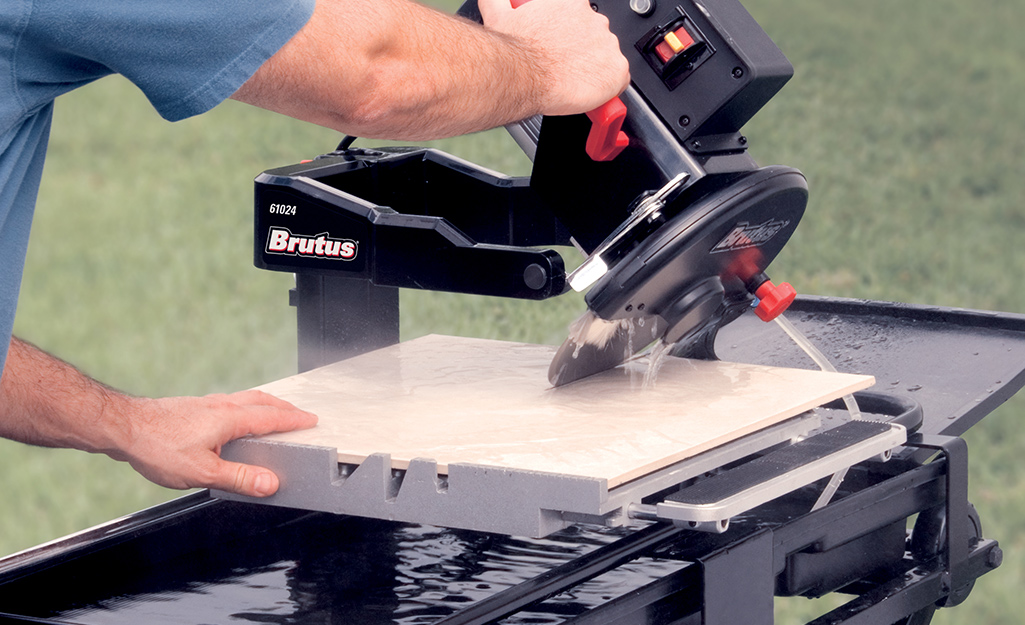Can I Cut Tile With a Table Saw
Tile has been used as a building material for centuries and is an incredibly versatile product. Whether you’re setting up a new kitchen or bathroom, adding some decorative flair to your outdoor patio, or replacing existing tiles in any area of your home, you may be wondering if it’s possible to cut tile with a table saw. The answer is yes – but only if you use the right tools and safety precautions!
Cutting tile with a table saw requires specialized blades that are specifically designed for cutting through ceramic, porcelain, glass mosaic tiles, stone mosaic tiles and other types of hard materials. Additionally, there are certain steps that must be taken in order to ensure that the project turns out correctly and safely. In this blog post we will discuss what type of blade should be used when cutting tile on a table saw as well as provide tips on how best to set up the job so it can be done safely and efficiently.
- Step 1: Gather the necessary safety equipment
- Before cutting tile with a table saw, it’s important to make sure you have all the required safety gear such as goggles, face shield, dust mask and ear plugs
- Step 2: Measure the tile
- Measure out where the cut needs to be made on the tile
- Make sure to use a straight edge for accuracy when measuring and marking off sections that need to be cut
- Step 3: Set up your saw blade guard and blade height adjustment gauge according to manufacturer instructions or recommendations for cutting ceramic tile
- Generally this will mean setting the blade height at its lowest possible position while still allowing enough of it exposed above the surface of your material being cut so that it can do its job effectively without causing too much stress on either itself or your workpiece during operation
- Step 4: Securely install your diamond-tipped circular saw blade onto your table saw before beginning any cuts in order to prevent any potential accidents from carelessly installed blades slipping off during operation (remembering also that they must rotate in an anti-clockwise direction)
- Be sure no one is nearby who could potentially get hurt by flying debris from spinning parts when turning on power source! Step 5: Place your marked-off area of ceramic tile onto flat surface near miter slot; ensuring that there is plenty of room around edges for safe handling throughout entire process – including when making final adjustments if needed after each pass through material has been completed successfully! Carefully guide piece into place with both hands and steady pressure until secure contact has been made between two surfaces (do not force!)
- Once satisfied everything looks good then proceed slowly but confidently towards desired end result…

Credit: www.homedepot.com
Can You Cut Tile With a Regular Saw?
Tile saws are the best tool for cutting ceramics, porcelain and stone tiles. However, if you find yourself in a pinch and don’t have access to a tile saw or other specialized tools, you may be wondering if it is possible to cut tile with a regular saw. The answer is yes, but there are some important considerations that should be taken into account before attempting this task.
First of all, it is important to recognize that not all types of regular saws can be used to cut tile. A jigsaw will likely not work as the blade is too short and rigid for making precise cuts on curved lines or intricate shapes like circles. It also does not provide enough stability on slippery surfaces such as those found on ceramic tiles.
Instead, look for a circular saw with carbide-tipped blades specifically designed for cutting hard materials such as masonry or stone tiles. Make sure the blade has at least 12 teeth per inch so it won’t get gummed up when cutting through dense material like grout or mortar joints between tiles.
You will also need some additional supplies in order to ensure your safety while using the circular saw: safety glasses/goggles; dust mask; hearing protection; gloves; kneepads (if necessary); measuring tape; leveler/straightedge guide (to make straight cuts); chisel (for detailed work) and wet sponge (to clean excess debris).
Before beginning your project make sure you have everything you need within reach so you can complete your task quickly without any extra trips back and forth from the store!
In addition to having the right equipment and supplies ready beforehand, another key factor in successfully completing this job is patience – take your time! When laying out pieces of tile prior to cutting them mark each piece clearly with an X indicating where they should be cut then double check measurements twice before making any final cuts.
Start off by setting up two sawhorses parallel along one edge of each piece of tile – these will help keep things steady during use so try not too rush through this step! After positioning them correctly place either end of long straightedge guide onto both sides of marked area then secure firmly using clamps provided with kit -this helps create nice even cuts across entire length desired surface every single time! Finally slowly start running circular blade over line until desired depth achieved -remember go slowly as going too fast could cause cracking due damage heat generated due friction created between two objects coming contact together under pressure .
Once done cleaning up remaining debris easy process just wipe away dust water damp cloth let dry completely before moving onto next step installation phase project completion success!!!
What Type of Saw Do You Use to Cut Tile?
Tile is one of the most popular materials used in home construction and renovation projects. It comes in a variety of shapes, sizes and colors, making it easy to customize your space to fit your personal style. However, before you can install tile, you need to make sure that it’s properly cut.
The type of saw you use to cut tile depends on several factors including the thickness and material of the tile as well as the desired finish.
The most common tool for cutting tile is a wet saw which uses an oscillating blade submerged in water to reduce heat buildup while cutting porous materials like ceramic or porcelain tiles. This ensures that there are no chips or cracks along the edges after cutting.
Wet saws come with adjustable blades so that they can be adjusted according to different thicknesses of tiles and also provide smooth cuts with minimal dust production during operation – making them ideal for both indoor and outdoor installations alike.
For thicker tiles such as natural stone varieties like granite or marble, a diamond-tipped circular saw may be necessary since these products are too hard for standard wet saw blades alone to handle effectively without chipping or cracking due to excessive pressure build up from friction against their hardness level during operation process . Additionally, this type of saw offers greater precision when compared with other types because its diamond-tipped blades naturally follow curves more easily than straight edged ones do; thus allowing users greater flexibility when creating intricate designs using natural stones tiles at any size they choose (while still providing clean cuts).
In order words – if you’re looking for accuracy above all else then this is definitely what we’d recommend!
No matter what type of project you have in mind involving tiling work – whether residential or commercial – having access to quality tools will help ensure successful results every time! When choosing which type of saw will best meet your requirements remember: always keep safety first by wearing proper protective gear such as goggles and gloves while operating either wet or dry tile cutters at all times – no exceptions!
Can a Diamond Blade Be Used on a Table Saw?
When it comes to cutting through tough materials, nothing beats a diamond blade. But can a diamond blade be used on a table saw? The answer is yes, but there are several things you should consider before using one.
First off, not all table saws are compatible with diamond blades. You’ll need to make sure your saw has the proper arbor size and that the motor power is sufficient for working with such a hard material. Most standard jobsite or contractor-grade table saws won’t have enough power; instead look for cabinet grade models with at least 3 HP motors and 5/8” or larger arbors for best results when using a diamond blade.
Aside from having the right setup, you must also take into consideration your safety when using any type of circular saw blade. Diamond blades create more heat than other types of blades due to their hardness so work slowly and keep an eye out for sparks as these could indicate that something isn’t quite right in terms of fitment or speed settings (diamond blades need higher RPM speeds). Additionally, always wear protective gear such as gloves, goggles & dust masks when operating any kind of machinery like this.
Finally, if you plan on buying a new diamond blade specifically for use on your tablesaw then check what type of material it’s designed to cut – some are better suited to softer materials such as wood while others will be able to cut through tougher stuff like concrete or granite tiles much easier than standard carbide tipped alternatives. Be aware too that some very hard stones may require wet cutting which requires specialised equipment – if in doubt get professional help!
How Can I Cut Tile Without a Tile Saw?
If you’re a DIYer or just need to cut tile for a project, it can be daunting to try and figure out how to do it without access to a tile saw. Fortunately, there are several ways that you can easily and effectively cut tiles without the use of such a tool.
The first way is with an angle grinder.
This device features spinning blades that allow you to make accurate cuts in various materials like stone, ceramic or porcelain tiles. To use this method you will need two important things: an angle grinder equipped with either diamond-tipped blades or abrasive cutting discs, and safety glasses (or goggles). Begin by marking where your desired cut should be made on the tile surface using a marker pen; then position the blade so that it is at 90 degrees relative to the surface of the tile before powering up your angle grinder.
Once powered up slowly move the blade along your marked line until reaching its end point; if necessary perform multiple passes over small sections at once in order for deeper and more accurate cuts. Lastly, turn off your machine and remove any debris from within your newly created line before attempting further work on said area of tiling material.
Another popular method which can also be used when cutting tiles without access to specialised tools like wet saws is scoring wheel technique – commonly known as ‘snap’cutting – which requires only very basic equipment such as manual snap-cutters (available online) plus nippers or bolt cutters for making fine adjustments after snapping has taken place.
Firstly mark out where required cuts should take place on both sides of any given part of tiling material; then carefully aligning wheeled device over these markings press down firmly while moving cutter handle backward/forward along desired section until scoring action starts taking shape inside marked area(s). After completing score lines apply light pressure against side nearest previously scored lines while pushing other side away from them in order reach breaking point – resulting pieces should then separate cleanly along preestablished grooves allowing user complete control during whole process whilst ensuring accuracy remains high throughout entire procedure!
Finally another excellent way which anyone can utilise when trying tackle tricky task involving removal/alteration existing tiles involves utilizing masonry drill bit set alongside hammer chisel combo kit – ideal option those who wish avoid using heavy duty power tools but still require results similar what electric version would yield!
Start by measuring distance between edges intended breakage points before drilling holes into specified locations using appropriate sized bit selection available within aforementioned set followed coarse application hammer chisels against drilled spots until pieces start separating freely – leaving behind perfect rectangular shaped opening exactly according plan laid out earlier stage project planning phase!
5 Ways to Cut Tile – Everything You Need to Know for Your First Tile Project
How to Cut Porcelain Tile With a Table Saw
If you’re looking for a way to cut porcelain tile with precision and accuracy, then the table saw is an ideal tool. Table saws are designed to cut through hard materials such as wood, stone and even ceramic tiles. Here’s how to use a table saw to make perfect cuts in your porcelain tile:
1. Safety First: Before beginning any project involving power tools, be sure that you take all necessary safety precautions including wearing protective eyewear and gloves. Also, make sure the area is clear of bystanders so no one gets hurt during the cutting process.
2. Set Up Your Saw: To set up your saw correctly for cutting tile, lower the blade guard until it just barely touches the surface of your tile when pushed against it from above.
This will help prevent any potential kickback or other accidents while using the saw on this hard material like porcelain tile. If you’re using a wet-cut diamond blade specifically made for cutting tiles, also attach it securely onto your table saw before proceeding with further steps in this process..
3. Mark Tile & Cut: Now that everything’s ready to go at this point – mark out where exactly on your porcelain tile needs to be cut (using either a marker pen or pencil) and place it onto the miter gauge on top of your table saw carefully making sure its properly secured into place before turning on machine . Once secure , turn machine on slowly and gently push forward along marked line ensuring steady pressure all throughout motions . Keep pushing until entire length has been successfully gone through by blade Finally switch off machine after finished !
4 Cleanup : Make sure there’s no dust particles left behind from cutting procedure – if there are , sweep them away carefully with soft brush or vacuum cleaner . After doing thorough cleaning , check once more whether everything looks satisfactory before moving onto next step !
By following these simple steps – anyone can easily learn how to safely use their own table saw for accurate cuts when working with porcelain tiles!
Conclusion
Hey there – so you’re wondering if you can cut tile with a table saw? Well, the answer is yes and no. Yes, it is possible to use a table saw for cutting ceramic tiles but it’s not the ideal tool for this job.
Table saws are made from metal and tend to be too hard on brittle materials like ceramic tiles which run the risk of chipping or cracking during your cut. It’s also difficult to get accurate cuts using a table saw since most blades don’t have enough torque power or high enough RPMs that you need when cutting through tough surface material like tile.
So while it is possible to make some basic straight cuts with a table saw, using an alternative tool such as wet tile cutter will give you better results in terms of accuracy and speed without risking damage to the tiles.
A wet tile cutter uses rotating diamond-tipped blades that allow precise control over your cut while providing plenty of power to slice right through even thick porcelain or stone tiles quickly and easily. In addition, these tools minimize dust by spraying water onto the blade as it spins which helps keep your workspace clean throughout your project.
So there we have it – although technically possible, using a table saw isn’t necessarily recommended when cutting ceramic tile because of its lack of precision and potential for damaging delicate surfaces like porcelain or stone tiling.
If you want more accurate results then investing in an appropriate wet tile cutter would be best option!


